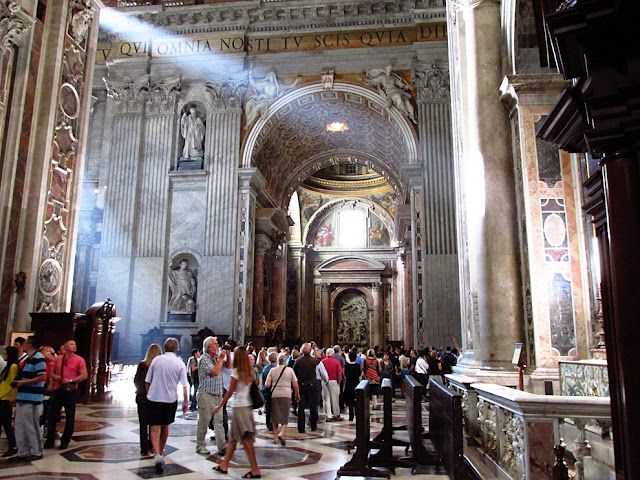After spending most of the day in the Vatican Museums, we said to ourselves, "Hey, let's go stand in another ridiculously long line!" Luckily this one was for St. Peter's Basilica which happens to be (a) free, and (b) unbelievably beautiful.
I can't even begin to explain (or understand) much of the history of the building and the contents therein, so check out the
Wikipedia page here.
The line moves relatively quickly, and we made our way to the main entrance relatively quickly.
 |
| Statue of St. Paul |
 |
| The Holy Doors at the main entrance. Any Latin majors want to help me with the translation? The body of John Paul II isn't far from here, so I'm assuming it has something to do with that. |
St. Peter's is, hands down, one of the most spectacular museums / historical sites that I've ever seen. Honestly, I think even the most devout atheist would agree.
 |
| After walking in the front doors. |
 |
| Impressive, no? More Latin. |
 |
| Just ONE of the domes (not the big one). |
 |
| That's the "main" dome above with the alter (Baldacchino) on the lower right. |
The sunbeams (Crepuscular Rays for you science folk), really add to the beauty of the building and art therein. These photos really don't do it justice.
There are two "sites" within St. Peter's that are
very popular with tourists, the Pietà and the Tomb of John Paul II.
The Pietà is a masterpiece work by Michelangelo, and the only work he ever signed (something he soon regretted and vowed to never do again). Much more information, including some interesting interpretations of why Mary looks so young can be found at
the Wiki page.
Finally, I wanted to see the tomb of John Paul II, arguably the most popular Pope in memory (if not "ever"). I highly respected the man and most of his teachings during his lifetime.
What I didn't take photos of was the awesome
Vatican Grottos and Necropolis beneath the main alter. We were able to see the upper level of the Grotto, but there's apparently a level below that, and another area with deeper / more hidden tombs. The Necropolis is a much larger subterranean system that contains pagan gravesites as well as VERY early Christian tombs, including what is more than likely the remains of
St. Peter himself.
If you'd like to find out more,
this is the best link I could find, although the
wiki page is also helpful.
- B

















The inscription basically relates to the Holy Doors and the right panel says that Pope John Paul II opened and closed them to mark the beginning and end of the Year of Jubilee from 2000 to 2001.
ReplyDeleteThe left panel says (I think; I don't know Latin) that Pope Paul VI opened and closed the Holy Doors in the Jubilee Year 1975, and that Pope John Paul II opened and closed the Holy Doors in the Jubilee Year 1983-84.
More here: http://en.wikipedia.org/wiki/Holy_door
Essentially, P.M. stands for Pontifex Maximus, the Pope's official title.